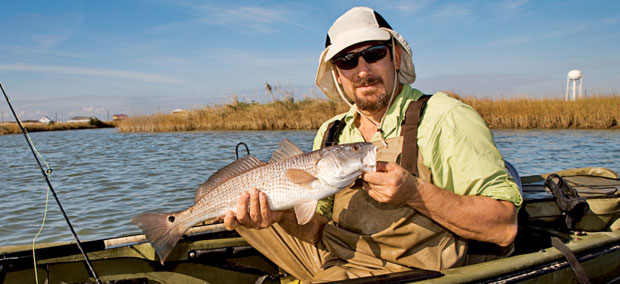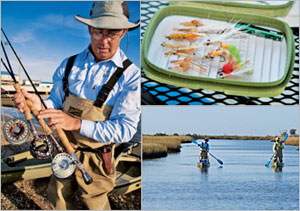sierraclub.org - sierra magazine - may/june 2009 - marsh madness


Marsh Madness
Casting for Redfish and Sleigh Rides in the Louisiana Delta
By Dan Oko

The author shows off a feisty Grand Isle redfish. Note the tail's distinctive dot.
"Look at that swamp rat," my guide, Danny Wray, called out. "He knows just what to do."
Captain Wray, a longtime Louisiana fishing guide, had dropped anchor a few feet from where I--the swamp rat in question--stood wobbling on a plastic kayak made for sitting. The mid-morning sun shone through a hazy sky. The breeze bore the sweet, sulfuric scent of decay. I stood and paddled cautiously, my fly rod at the ready, waiting for a chance to make the perfect cast.
A milky maze of waterways crisscrossed thousands of acres of emerald marsh grass. A heron croaked. My paddle scraped Grand Isle's shallow bottom, and I sucked my breath and scanned for the telltale wake left by red drum retreating. Also known as redfish, the prized and tasty species is considered the marine bulldog of the Gulf Coast, a kind of cross between a carp and a defanged alligator. Having set my sights, I knew it wouldn't be long before my skill was tested.
Strong, not smart, is how Wray described the redfish, though he left out that they also can be shy. I have been on wade trips where guides have cautioned that the lapping of water on legs can scare off big reds. Once, on a windy day in Texas, my long-distance casting difficulties apparently spooked every red within miles. This time, on Grand Isle, when I paddled my kayak into a narrow channel and saw the welcome sign of spartina vibrating in a deepwater current, the murky bottom disappearing to darkness, I beached the boat and opted for terrestrial stealth. I stepped to stable ground, coiled a handful of line in my free hand, and moved my rod like a baton. My line shot about 15 yards, and my imitation-shrimp fly dropped into the slow-moving pool.
 Clockwise: Saltwater fly rods, the tools of Danny Wray's trade; a box of gaudy flies designed to look like shrimp and other aquatic delectables; Wray and the author scan the shallows in channels well suited for small, quiet craft.
Clockwise: Saltwater fly rods, the tools of Danny Wray's trade; a box of gaudy flies designed to look like shrimp and other aquatic delectables; Wray and the author scan the shallows in channels well suited for small, quiet craft.Bam!
The strike sent a jolt up my arm. My reel screamed. I worked the drag and leaned back to keep pressure on my adversary.
"Fish on!" I crowed.
For more than two decades now, anglers have been using kayaks to gain easy access to oceans, lakes, and rivers from Southern California to Chesapeake Bay. Powered by muscle and capable of navigating nooks too shallow for motorized skiffs, kayaks appeal not only to Hemingway wannabes obsessed with the mythic pursuit of large fish from small boats, but also to casual paddlers who simply want an inexpensive vessel for weekend water tours.
Although the kayak-fishing wave has swept across the Gulf of Mexico, Louisiana remains one of the last areas to be discovered by self-propelled anglers. Given that a decent kayak can be bought for about a thousand bucks (as opposed to the tens of thousands for a serious bay boat) and that there is no fuel cost beyond snack food and six-packs, the sport seems certain to grow here.
Of course, kayak fishing is far from a modern invention. Arctic natives have paddled sealskin boats for some 4,000 years. The latter-day incarnation bloomed in the 1980s, when plastic sit-on-top kayaks designed by a boat maker named Tim Niemier started displacing older fiberglass paddle craft. Niemier molded his early boats with divers in mind, but anglers easily adapted them to suit their needs.
Today fishermen outfit their kayaks with live wells for bait, electronic fish finders, and global positioning systems. Jim Sammons, a La Jolla, California-based guide who has been on the sport's forefront since it was reborn 25 years ago, was recently with a kayaking client who hooked a 300-pound blue marlin that took five hours to land. "Chasing billfish is one of the extremes," Sammons says. "But all anglers are gear junkies. We see something new and our first thought is, 'We have got to have that.' Kayaks are still the cheapest way to get on the water."
I'd tracked down Captain Wray via online fishing reports from Grand Isle, an eight-mile-long barrier island at Louisiana's southern tip, formerly famed as a hideout for the 19th-century pirate Jean Lafitte. Located at the heart of the Barataria and Terrebonne Basins, one of the largest estuary systems in the Mississippi Delta, the island is the epicenter of the "Redfish Riviera," where shallow saltwater bayous and brutish game fish make a perfect kayak-fishing twofer.
In recent years Grand Isle has had the misfortune of being battered by hurricanes, including Katrina and Rita in 2005 and Ike and Gustav in 2008. Wind and waves are a constant part of island life. (Despite the Army Corps of Engineers' efforts to reinforce the dune-lined beaches after the 2005 disaster, Grand Isle flooded three years later when Ike took aim at Galveston, Texas, some 200 miles away.) Many houses, restaurants, and shops are still boarded up or in need of repair. Beyond hosting redfish and a world-class collection of shorebirds, the saltwater marsh also serves as a repository for worn-out appliances, rust-spotted bathtubs, abandoned cars, and the occasional bulldozer. Debris notwithstanding, Grand Isle retains an offbeat, beach-town vibe. Surreal sunsets enhanced by nearby refineries are commonplace.

From left: "Fish on!"; rust-prone reels get an end-of-the-day rinse; Rudolph the Redfish.
"The old-timers say to me, 'You dat boy who paddles dem plastic pirogues,'" Wray said, chuckling, as we prepared the kayaks, referring to the traditional, flat-bottomed skiffs still used in the Cajun swamps. A lifelong fisherman and longtime surfer, Wray decided in 2002 to quit his job marketing cleaning services to petrochemical outfits to launch Calmwater Charters. Though neither is native to Louisiana, the fiftysomething-year-old guide and his cheerful, patient wife, Kristen, are happy ambassadors for Grand Isle.
In season, when 40-pound reds capable of pulling a man and his boat out to sea come to spawn, Wray likes to wet a line in deep channels for what he calls a "Cajun sleigh ride." He's not alone. In fact, the species was nearly fished to extinction 30 years ago, thanks to a sudden nationwide taste for New Orleans-style "blackened" redfish. With wholesale prices soaring, gillnetters all but decimated the region's population of redfish and speckled trout--until a handful of activist anglers from Texas created something called the Gulf Coast Conservation Association (now the Coastal Conservation Association, with chapters from Maine to Oregon). The group's Save the Redfish campaign did just that, pushing through state legislation that banned commercial harvests and designated the tasty prey as a game fish.
When it comes to fishing gear, Wray is a steadfast minimalist. His contribution to the cause consisted of kayaks (sturdy 12- and 14-footers with elevated canoelike gunwales), life jackets, stakes for anchoring in the shallows, rod holders, and flies. I had brought my own nine-foot, eight-weight rod. He set me up with a fresh leader and affixed a woolly imitation-shrimp fly to the tippet. I caught a few feisty redfish to start. Then I hooked a 20-inch, six-pound lunker and put my feet up. The ride was more snowplow than toboggan, but I would take my thrills any way they came.
The legitimate thrill arrived later, when I was out of the boat, standing in marsh grass, and dropped my line in the slow-moving pool. The fish that took my line that time was a brute of an altogether different nature. It felt as if I'd hooked a Volkswagen Beetle. The fish fought hard, but I held on tight. There was a splash, and then--as abruptly as the run had begun--the line went slack. Despite my best effort, my sometimes sloppy casts had combined with a steady breeze to produce a tiny twist familiar to frustrated flyrodders the world over: the dreaded wind knot. On the Louisiana coast, the wind can sting at any time. I'd lost the fish of a lifetime, but found solace in knowing that the hook would rust away after a few months spent soaking in the saltwater.
Watching nearby, Wray remained untroubled by my catch-and-release technique, even though I'd omitted the "catch" part. The fish might have escaped, but my guide could see he'd hooked a swamp rat for life.
Dan Oko is a freelance writer based in Austin, Texas. His article "Cool Products for an Eco-Home" appeared in Sierra's January/February 2009 issue.
Photos by Rick Olivier